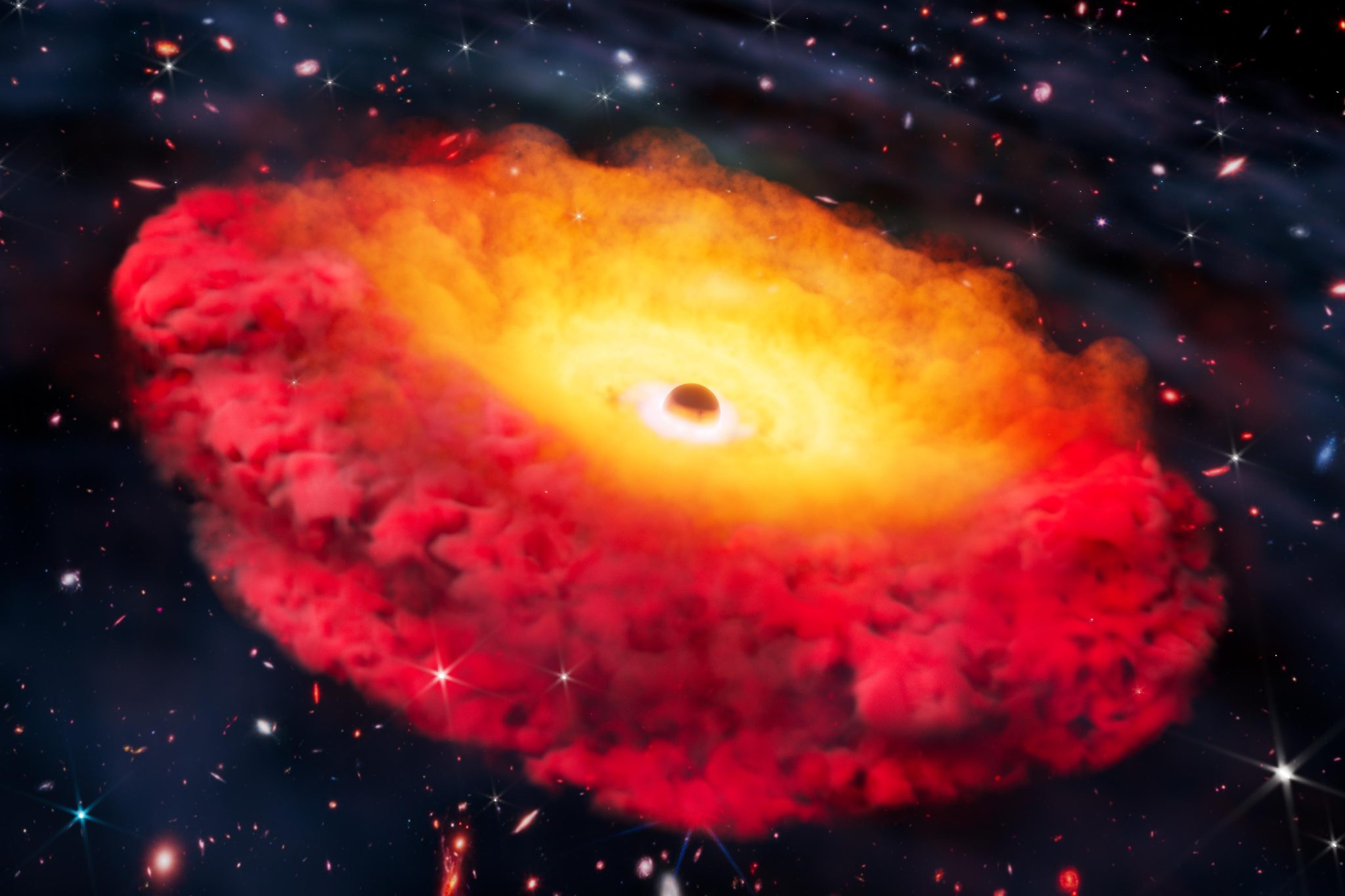🔭 This black hole upends all theories!
Follow us on Google News (click on ☆)
To detect this black hole, researchers used spectroscopy, a technique that breaks down light into its different wavelengths. They looked for the specific signature of gas moving at high speed around the black hole, which stretches the light toward red or blue. This method allows confirming the presence of a black hole with great accuracy, as few other phenomena produce such a signal.

Artist's representation of CAPERS-LRD-z9, hosting the oldest confirmed black hole. The supermassive black hole is surrounded by a thick cloud of gas, giving the galaxy its distinctive red color.
Credit: Erik Zumalt, The University of Texas at Austin
The James Webb Space Telescope provided the necessary data through its CAPERS program, designed to study the most distant galaxies. Launched in 2021, this telescope offers an unprecedented view of the far reaches of the Universe. Observations revealed that CAPERS-LRD-z9 belongs to a new class of galaxies called 'Little Red Dots', which are compact, red, and very luminous.
The exceptional brightness of these galaxies suggests the presence of supermassive black holes rather than an abundance of stars. By absorbing matter, black holes generate intense light and energy. The distinctive red color could be due to a dense gas cloud surrounding the black hole, which filters the light and makes it redder.
The mass of the black hole in CAPERS-LRD-z9 is estimated at 300 million times that of the Sun, representing up to half of its galaxy's stellar mass. Such a size so early in the history of the Universe challenges current models of black hole formation. Astronomers believe these objects may have grown much faster than expected or were initially more massive.
Future observations with the James Webb Telescope will allow deeper study of CAPERS-LRD-z9 and help understand the role of black holes in the evolution of Little Red Dots. This discovery opens new perspectives on the processes that shaped the early Universe.
How do astronomers detect distant black holes?
Astronomers mainly use spectroscopy to identify black holes. This technique analyzes light emitted by celestial objects by breaking it down into different colors or wavelengths. Each chemical element or physical condition produces a unique signature in the light spectrum.
For black holes, researchers look for signs of gas moving at extreme speeds. When matter falls toward a black hole, it accelerates and emits light. Light from gas moving away from us is shifted toward red, while that approaching is shifted toward blue, a phenomenon known as the Doppler effect.
This spectral signature is rare and distinctive, as few other astrophysical phenomena can produce it. By comparing this data with theoretical models, scientists can confirm the presence of a black hole and estimate its mass and activity.
The James Webb Space Telescope, with its advanced instruments, significantly enhances this capability by observing infrared wavelengths, ideal for studying very distant and ancient objects in the Universe.
What is a 'Little Red Dot' in astronomy?
'Little Red Dots' are a recently discovered class of galaxies that existed in the first 1.5 billion years of the Universe. They are characterized by their small size, intense red color, and surprising brightness, distinguishing them from more typical galaxies observed previously.
Unlike normal galaxies, where brightness comes mainly from stars, that of Little Red Dots is often attributed to the activity of supermassive black holes at their center. These black holes, by accreting matter, heat and ionize the surrounding gas, producing very bright light.
The red color of these galaxies can be explained by the presence of dense, dusty gas clouds around the black hole. These clouds absorb and redistribute light, making it appear redder. This contrasts with blue galaxies, which are generally rich in young, hot stars.
The study of Little Red Dots helps astronomers understand how the first structures of the Universe formed and evolved. They may represent an important phase in the development of galaxies and supermassive black holes.